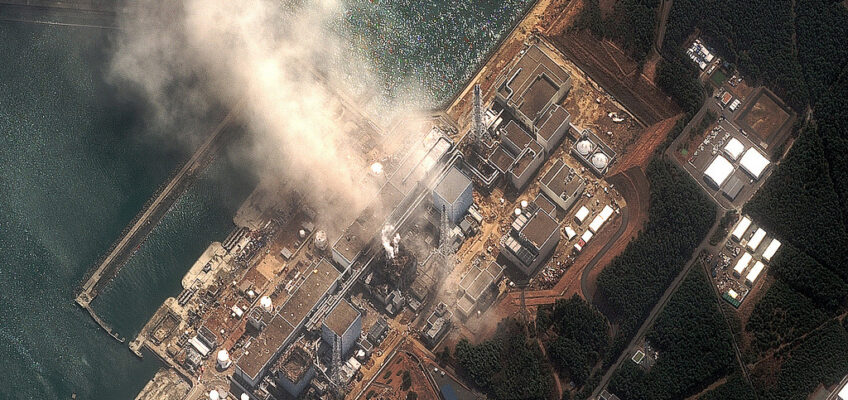Image (above): Aerial view of Fukushima courtesy of Fairewinds Energy Education
On May 16, 2016, the Seacoast Anti-Pollution League held their annual meeting at the Portsmouth Public Library’s Levenson Room. The event featured a forum on the current state of Fukushima five years after the initial disaster and the future operation of the Seabrook power plant.
This forum featured guest speaker Arnie Gundersen, chief engineer at Fairewinds Energy Education. Gundersen had just returned from a fact-finding trip to Japan where he was able to study the aftermath of the Fukushima disaster first hand.
LESSON 1: Reactor containments do NOT maintain their integrity.
Hydrogen explosions in the units at Fukushima resulted in shock waves that compromised the containments and resulted in the release of massive amounts of radiation. While the Nuclear Regulatory Commission maintains that U.S. nuclear facilities can withstand these shockwaves, the Fukushima Daiichi triple meltdown has proven this statement to be false. Not only is Seabrook’s containment unable to withstand a similar detonation, the situation at Seabrook is even more serious because the structure is already experiencing micro-cracking (ASR concrete degradation). The fact is, no power plant can withstand these shock waves. The NRC’s position is that reactor containment integrity cannot be compromised, but we now know that it can – because it has happened.
Containments also leak excessively, as they are held together by deficient bolts and valves. When the systems at Fukushima became heated, the heated bolts expanded and allowed hot radioactive gasses to leak out.
LESSON 2: The NRC is not taking into account the true cost of a nuclear accident.
When we choose how to power our businesses and homes, we assume that we are making calculated choices based on facts. Unfortunately, when the commission in charge of regulating the nuclear industry fails to properly account for the true cost of a nuclear accident, we cannot begin to address the choice in a realistic manner. The Fukushima incident has cost $40 billion already and is expected to cost $250 billion or more to complete, this does not include the estimated economic losses of $250 – 500 billion.
We MUST start accounting properly for the cost of an accident. In many ways, it would be nearly impossible to do; when you consider the fact that nearby communities would be uninhabitable in such accidents, any cost-benefit analysis would be distorted beyond recognition. How do you account for entire towns being declared indefinitely uninhabitable, as has happened in Japan? Towns further out than our own evacuation radius? Rendering the entire seacoast of New Hampshire uninhabitable for decades is not an acceptable risk under any circumstances, let alone for an energy plant with so little reward.
LESSON 3: Spent fuel pools are a SERIOUS safety issue.
Nuclear waste can be stored in wet or dry storage. Wet storage involves keeping the waste in “spent fuel pools.” Spent fuel pools are designed to contain 5 years of waste from a plant. When these pools are full, they are a serious safety issue, as they are more easily compromised than dry cask storage. (In dry cask storage, the waste can be air cooled and doesn’t require power. The Fukushima dry casks survived the tsunami, the earthquake, and the resulting power outage.) At the time of the Fukushima disaster, their spent fuel pool contained 7 years of waste, and it was the very reason that the United States government urged Americans to evacuate beyond 50 miles from the site.
Now consider Seabrook. We have over two decades of spent fuel in the waste pool at Seabrook. For them, it is a matter of cost. If they continue to fill the fuel pool, they can save the money from their decommissioning fund for covering the cost of removing that nuclear waste. Again, these pools are only designed for 5 years of waste. Seabrook has several times more fuel in wet storage than Fukushima did at the time of their accident (effectively containing the same radioactivity as 700 atomic bombs), and we need to address this issue sooner rather than later.
 ABOUT THE SPEAKER
ABOUT THE SPEAKER
Arnie Gundersen is an exceptionally reliable source of information on nuclear power. He has more than 40 years of nuclear power engineering experience with a master’s degree in nuclear engineering. He is a past Atomic Energy Commission Fellowship recipient. Gundersen holds a nuclear safety patent, was a licensed reactor operator and nuclear industry senior vice president, and has managed projects at 70 different nuclear plants across the United States.
Arnie Gundersen is keenly aware of the failures in current nuclear power policy and the potential dangers of aging plants in our country. He now works with Fairewinds Energy Education to educate the public on nuclear power.
MORE READING
- Fukushima disaster topic of SAPL forum
Article from Seacoastonline, May 12, 2016 - 5 years later, Fukushima radiation continues to seep into the Pacific Ocean
Article by Dr. Ken Buesseler, a marine radiochemist with the Woods Hole Oceanographic Institute. Published by the PBS Newshour March 9, 2016
LEARN MORE
Issues with the Seabrook Emergency Evacuation Plan »
“Growing renewable power sources have become a key factor leading to the closure of several nuclear plants around the country in recent years. The [Seabrook] plant also came under increased scrutiny from federal regulators for the discovery of degrading concrete in its foundation walls.”
Seacoastonline, May 12, 2016

